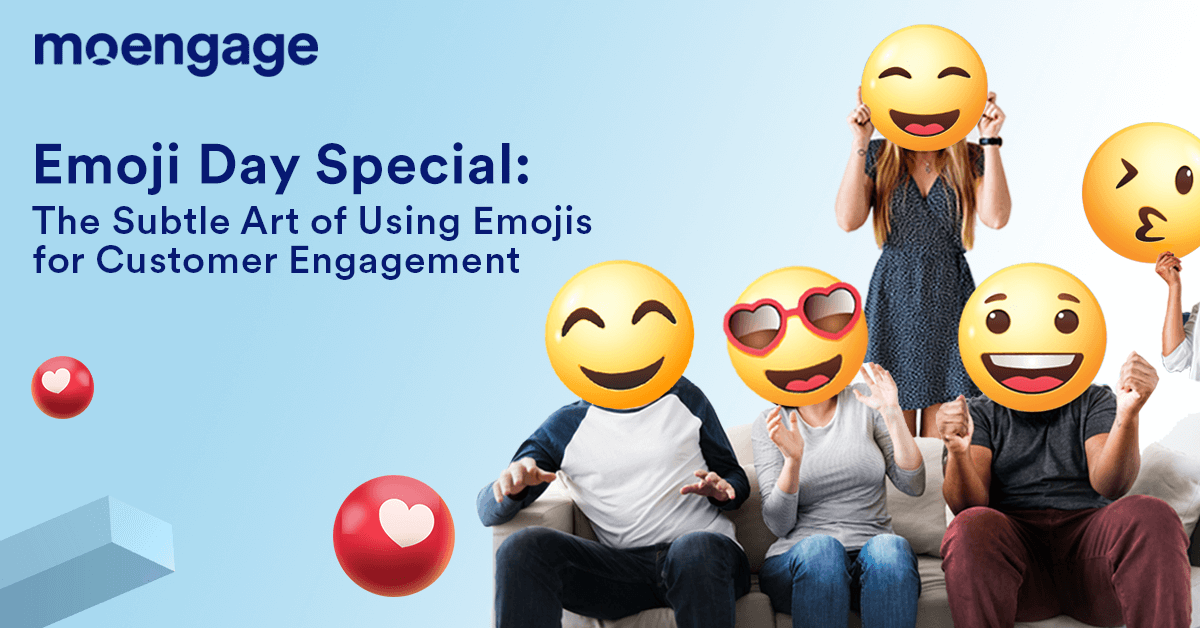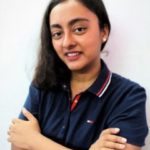The Subtle Art of Using Emoji Marketing for Customer Engagement

Reading Time: 8 minutes
Last year, there was a social media frenzy after LinkedIn added the ‘laughter emoji’ 😄 in their ‘reactions’ emoji suite. Interestingly enough, it was one of the top feature requests LinkedIn has ever received.
So, why was this a big deal?
Humans are social beings with an innate desire to connect with others and express themselves. And when it comes to virtual communication, what’s a better way to do that than emojis?
A few years ago, would you have imagined a professional platform like LinkedIn offering emoji reactions? Probably not.
According to Unicode, the global IT standard for text and emoji, 92% of the world’s online population use emoji.1 Furthermore, a recent study by TextAnywhere indicated that more than 44% of Britons use emojis in their workplace texts and emails.2
Emojis have steadily gained worldwide acceptance, from being used in daily text messages to now being used in workplaces and even customer engagement campaigns.
If you’ve been thinking about implementing emoji marketing in your marketing strategy, here are the key benefits, examples, and best practices to get you rolling.
Benefits of Using Emoji Marketing for Customer Engagement
1. Humanizes Your Brand 👧👦
Consumers associate emojis with the expression of emotions. This makes them one of the most personal forms of virtual communication.
Just including a few emojis adds depth and realism to your messaging. It allows you to connect with your customers in a fun and creative way, making your brand relatable and approachable.
2. Aids Your Messaging 💌
In face-to-face communication, humans can express their feelings through different facial expressions.
Facial expressions act as contextual cues, along with gestures, body language, tone of voice, etc., to convey a message. But in the virtual world, with these contextual cues missing, emojis equip you with the right arsenal to ace your digital communication.
3. Breaks Language Barriers 🌐
Emojis are a universal language, which means anyone from any part of the world can understand them. So, even when words fail to convey your messaging, emojis can help you set the correct meaning, tone, and brand voice.
Furthermore, as virtual communication styles are changing rapidly, emojis can help you speak in the language your customers love to talk.
Digital Channels Where Emoji Marketing Can Be Used
1. Social Media
Social media is one of the best places for brands to have personal conversations with their customers. No wonder it is the place where emojis are most commonly used.
Here are some examples of brands that have their social media emoji game on point:
- Primark, the Irish multinational retailer, uses many emojis in their Twitter and Facebook posts to share the latest product additions and discounts. On the other hand, Primark’s social posts on LinkedIn have a very professional tone, where they talk about company-wide activities and those of its employees. Hence, they use emojis sparingly there.

| 🔍 Note: If you look at Primark’s Twitter account, you’ll notice that even though they use emojis in all their social posts, the formats of the posts are varied. While some posts announce product additions and prices, others are fun polls and ice-breaker questions. When planning your social strategy, look at how you can spice up your social media profile by experimenting with different emojis and types of posts. |
- Duolingo, the global language-learning app, use emojis heavily in their WhatsApp Marketing strategy. They send emoji-filled personalized reminders via their WhatsApp Business account, motivating customers to practice their language skills daily. Customers also have the option to answer a quiz question in the WhatsApp chat itself, to maintain their daily streaks. This helps to boost engagement as customers remain connected with the brand.

- Reynolds & Slater Opticians, a UK-based optician business, took emoji marketing to another level. They integrated marketing emojis into their digital marketing campaign via a fun challenge. They released five images of well-known places in Cornwell, including hidden ‘sunglasses emoji’ 😎. Followers were asked to test their eyesight by finding the emoji in the images and book an appointment with the company’s opticians in case they were unable to do so.
2. Email
How do you make your email communication stand out in a world where every other brand is trying to drive more engagement through email marketing?
The solution: Add an emoji or two in your email subject lines and preview text.
Email subject lines and content without emojis can appear bland. However adding emojis to your email marketing strategy helps to give character to your messaging.
Take the example of The Hustle, a media company that sends 5-minute newsletters daily to its subscribers with stories on business, tech, and the internet. The Hustle uses clever, highly relevant emojis in all their subject lines. These emojis work to get their emails highlighted in an inbox filled with multiple emails, increasing the chances of them getting opened.

| 🔍 Note: See how The Hustle uses minimal emojis, which are also relevant to the email’s subject line and preview text. This catches the reader’s attention and reinforces the subject of the email. Ensure the emojis you use in your emails aren’t there just for the sake of it but add some value. |
Some brands also leverage the space in the email body to increase engagement. A good example is Moka, Canada’s leading saving and investing app. When a customer gets onboarded on the Moka app, they send out an email describing all the activities they can do with their Moka accounts. Since this is an important, lengthy email, Moka uses different emojis to make the email fun to read and engage the reader.

3. Push Notifications
We’re seeing an increasing number of brands experimenting with rich media in their push notifications. However studies show that simply using emojis can boost push notification open rates by 85%. 3
No wonder, along with emoji use in its WhatsApp marketing, Duolingo also leverages them in its push notifications. It sends daily streak reminders, leaderboard updates, and friends’ accomplishments on the Duolingo app. Adding emojis to these notifications grabs the reader’s attention, and the messaging spurs healthy competition, motivating customers to keep returning to the app.

| 🔍 Note: See how Duolingo maintains consistency in its messaging across different channels, by using emojis on WhatsApp and in its push notifications. Aligning all your customer touchpoints ensures a smooth experience for your customers. |
4. SMS or Text Messaging
Text messages as a marketing channel have been gaining momentum in Europe and North America.
Yet, it is one of the least popular channels for emoji usage.
Why? Because using emojis in SMS requires the whole text message to be sent through the Unicode standard, This limits the character count, preventing marketers from sending longer messages.
Nevertheless, brands like Doe Lashes, a California-based beauty brand, and Bones Coffee Company, a Florida-based coffee company, use emojis heavily in their SMS marketing. This works well for them because their SMSes are personalized for the recipient and contain eye-catching emojis.

| 🔍 Note: When it comes to SMS marketing, you already have limited real estate to engage your customer, so make sure you use the space wisely. Limit the emoji use to one emoji per text. |
Best Practices for Using Emoji Marketing in Your Customer Engagement Strategy
Now that you have some inspiration for your customer engagement campaigns, let’s look at some of the best practices of emoji marketing:
1. Identify emojis that match your brand voice and maintain consistency across all channels.
- As of September 2021, there are 3,633 emojis in the Unicode Standard. 4 This means you have more than 3000 options to choose from. But you should pick only those most relevant to your brand personality.
- Also, if you want to make your brand seem approachable, stick to positive marketing emojis and not just any random emoji.
- Remember to focus on consistency when it comes to emoji usage, just like The Hustle does.
2. Do your research and know what the chosen emojis mean while outlining your emoji strategy.
- If you fail to use the appropriate emojis, you risk getting your messaging misinterpreted. This can be detrimental to your brand image.
3. Before choosing an emoji for your marketing campaigns, see how they look on different mobile devices.
- Unicode provides a detailed list of how your emojis look on different devices, including Android and iOS.
4. Consider the channel when choosing the type and quantity of emojis to use.
- In your email marketing messages, don’t use too many emojis. Keeping a balance on emoji usage will help you avoid spam filters and prevent low open rates. At the same time, it will keep the reader’s focus on your messaging.
- On the other hand, when it comes to your social media posts, you have the liberty to experiment with how you use emojis.
- Even within your social media strategy, consider differing your approach according to different platforms, similar to what Primark does.
5. Look at the context and tone of the message when deciding which and how many emojis to use.
- Studies have shown that using multiple emojis in your subject line during the holiday season works best as consumers are more open to reading funkier messages. But imagine how they would react to an email containing a financial 👏 report 👏 with liberally-used 👏 ‘clap emojis’ 👏.
6. Use emojis that resonate with your customers.
- Research to discover trends on what your customers like and do not like.
- According to a study by the online smartphone retailer, e2save, the ‘tears of joy emoji’ 😂 is the most popular emoji in the UK, while the ‘hugging face emoji’ 🤗, the ‘ok hand sign’ 👌, and the ‘flexed biceps emoji’ 💪 were ranked as the least favourite. 5 This is something you should take into consideration.
7. Don’t overuse emojis in your marketing messages; only add them if necessary.
- Adding too many emojis can make your message look annoying.
- From an email marketing perspective, it can increase the chances of your emails going to spam.
8. Conduct A/B Testing through an Intelligent Content Optimizer.
- A/B testing lets you compare two marketing campaign variations to see which one performs better. Test your emails to see if those with emojis perform better or those without. Similarly, you can see which and how many emojis are working best for your push notifications.
- Alternatively, using an Intelligent Content Optimiser will save you from all the manual work while artificial intelligence does the A/B testing for you in real-time.
Way Ahead: Embracing Emoji Marketing
Emojis are a powerful way to connect with your customers, although you must use them cautiously. Remember, insights are key to creating a successful customer engagement strategy. And just because something works for one brand, it doesn’t always have to work for you. Make sure you first use your customer engagement platform to understand your customers and then test out different variations of your message to see the best approach for you.
MoEngage’s insights-led customer engagement platform allows you to understand and engage with your customers across channels such as push notifications, WhatsApp, Facebook, SMS, and Email.
If you’re a customer-obsessed marketer, book a demo with us now to create hyper-personalized journeys for your customers.
References
- https://home.unicode.org/emoji/emoji-frequency/
- https://employernews.co.uk/news/over-two-fifths-of-employees-use-emojis-in-the-workplace/
- https://venturebeat.com/2017/02/27/emojis-boost-boost-push-notification-open-rates-85-study-says/
- https://emojipedia.org/faq
- https://businessinthenews.co.uk/2021/09/14/the-tears-of-joy-emoji-is-not-dead-after-all-its-the-uks-favourite-emoji-according-to-new-research/













